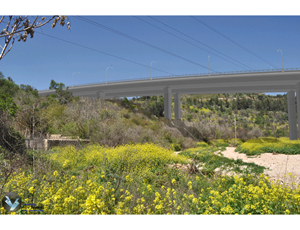

A major archeological site underneath and a tight timetable forced engineers to improvise solutions on a key bridge project that is part of the $800-million upgrade of Israel's main highway connecting Tel Aviv and Jerusalem.
Work on the two 800-meter-long precast spans on the Motsa Bridge along Highway 1 began in late August, part of a major rehabilitation and expansion of a 16-km segment that will add a third lane in each direction to ease congestion on one of Israel’s busiest arteries and improve safety of a particularly dangerous section.
“Under normal circumstances we would have built two separate bridges with a joint abutment,” says Yehuda Dugach, design manager for infrastructure projects at Israeli construction firm Danya Cebus Ltd., Tel Aviv, which was awarded the $170-million bridge project.
Tel Aviv-based Shamir, Posner Brown Construction Engineers Ltd. designed the project for the state-owned Israel National Roads Company Ltd. Dugach says the solution that was ultimately approved “creates one continuous bridge so the hill underneath where the archeological site is located remains accessible.”
The sensitivity of the location required inspectors from Israel’s Antiquities Authority to provide approve in advance the location of the bridge foundations. Before actual foundation work got under way last month, crews placed large sand-filled bags topped by a layer of high strength fiber sheeting to protect the archeological site, which had served since ancient times as a military camp for armies trying to conquer Jerusalem.
“The special protection of the hill along with the use of the overhead gantry crane should ensure minimal damage to the archeological site and the environment,” says Jerry Pfuntner, regional bridge engineer at Finley Engineering Group Inc., which is providing segmental bridge design and construction engineering services for the project.
The Tallahassee, Fla., firm has been involved in about two dozen major projects in Israel since the early 1990.
To meet the tight timetable, Danya Cebus and Finley are using a stationary lifter and a gantry crane. “This will allow us to split the project into two separate smaller jobs; building the actual bridge, while simultaneously filling the nearby ravine located below the highway,” says Pfuntner.
Initially, plans called for filling the ravine to create a working area for the gantry. But, Danya Cebus and Finley believe their novel solution of using a lifter on the eastern side of the bridge will enable them to reduce by eight months the original scheduled project completion, which now is set for August 2015.
The gantry and lifter being supplied by China’s Handan China Railway Bridge Machinery Co. are due to arrive in Israel at the end of the year.
The bridges comprise one of five tenders in the highway upgrade. Work already is under way on four of the five contracts.
In addition to the bridges, the upgrade consists of two 700-m-long parallel tunnels, three new interchanges, wider shoulders and the elimination of sharp turns and steep climbs.
The entire project is expected to be completed by 2017.















Post a comment to this article
Report Abusive Comment